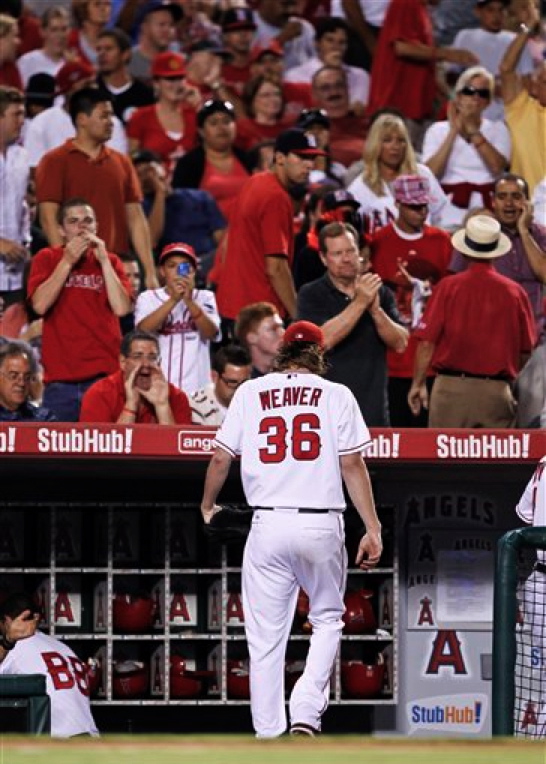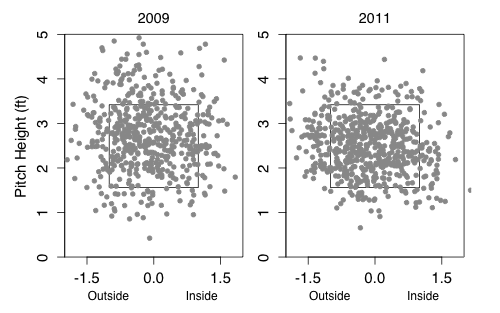
| Baseball Beat | August 25, 2011 |
I went to the Angels-White Sox game last night and sat in the first row behind the home team's dugout. If you had your choice of any seats in the stadium, the ones that my friend Glen, brother Tom, and son Joe occupied on Wednesday evening would rank right there with the best of them.
 I wore a red Angels shirt to root on Jered Weaver, who was making his first start since signing a five-year, $85 million extension last weekend, and the Halos. As it turned out, Weaver shut down the Pale Hose, tossing seven scoreless innings as the Angels trounced the visitors, 8-0, for the club's sixth consecutive victory. The Angels are now 71-59 and just 2.5 games behind the first-place Texas Rangers in the American League West.
I wore a red Angels shirt to root on Jered Weaver, who was making his first start since signing a five-year, $85 million extension last weekend, and the Halos. As it turned out, Weaver shut down the Pale Hose, tossing seven scoreless innings as the Angels trounced the visitors, 8-0, for the club's sixth consecutive victory. The Angels are now 71-59 and just 2.5 games behind the first-place Texas Rangers in the American League West.
Manager Mike Scioscia pulled Weaver after the seventh inning even though Jered had only thrown 96 pitches. With the Angels heading to Texas for a three-game series beginning on Friday, the speculation is that Scioscia plans to start his ace on three days' rest this Sunday. If so, the Rangers will face the Angels Big Three in Dan Haren on Friday, Ervin Santana on Saturday, and Jered Weaver on Sunday. Depending on the outcome of tonight's Boston-Texas contest, a sweep would either put the Angels a half-game behind or a half-game ahead of the Rangers with one month to go in the regular season.
Mat Gleason, aka Rev Halofan in the baseball blogosphere, tipped me off to the adjoining photo by Chris Carlson of the Associated Press. He cropped the photo and embedded it in his recap of last night's game. ESPN also ran the photo as part of Mark Saxon's game report.
I can be found with hands cupped around my mouth saying "complete-game shutout" to Weaver as he took his first step into the dugout after the seventh inning. Little did I know that Jered had thrown his final pitch of the evening. The Angels scored four runs in the bottom half of the inning, highlighted by three doubles off the bats of Erick Aybar, Alberto Callaspo, and Bobby Abreu. Bobby Cassevah and Fernando Rodney worked the eighth and ninth innings, combining with Weaver for a team shutout.
Weaver, who started the All-Star Game for the American League, leads the circuit in ERA (2.03); ranks second in CG (4), QS (23), QS% (0.89), and WHIP (0.97); third in W (15) and W-L% (.714); fourth in IP (195.1); and sixth in K (166) and K/BB (3.77). He also places third in BAA (.206) and second in OBP (.252), SLG (.310), and OPS (.562). Among advanced metrics, Weaver ranks first in ERA+ (185), Adjusted Pitching Runs (41), Adjusted Pitching Wins (4.6), Base-Out Runs Saved (46.6), Base-Out Wins Wins Saved (5.5), and Win Probability Added (5.1); and second in FIP (2.80), Component ERA (1.95), fWAR (5.5), brWAR (6.5), Situation Wins Saved (4.4), and Adjusted Game Score (64.6).
The 28-year-old righthander has been consistently excellent all season long. According to Saxon, "(Weaver) has pitched at least seven innings and given up one run or fewer 15 times this season, most in the majors." He set an Angels team record with 15 consecutive quality starts earlier this year, which is quite an accomplishment when you consider that Dean Chance led the AL in W, ERA, CG, SHO, and IP in his MLB Cy Young Award-winning season in 1964; Bartolo Colon was named the AL CYA winner in 2005; and Hall of Famer Nolan Ryan tossed four no-hitters and led the league in strikeouts in seven of his eight campaigns with the Angels. Weaver also bested, among others, Frank Tanana (14 consecutive complete games in 1977 when he led the league in ERA and shutouts), Chuck Finley, and Mark Langston.
While skeptics may point to Weaver's BABIP (.250), LOB% (83.7%), and HR/FB (4.6%) stats as indications that he has been "lucky" or benefited from strong defense and bullpen support, one could counter such an argument by pointing to the fact that he has been victimized by the second-worst run support (3.96) in the majors. Look, Weaver has been confounding the experts for years. Be it his pitcher-friendly home ballpark in college, his average velocity, throwing across his body, comparisons of looks and pitching style to brother Jeff, and his extreme flyball tendencies, the naysayers have had more than their share of reasons not to like the pitcher who nonetheless has succeeded at every stop along the way, from Long Beach State to Team USA to MiLB to MLB. The combination of his stuff, command, deception, competitiveness, and smarts places him among the elite pitchers in the game today.
As I introduced in May 2010, popups/pop flies/infield flies are "The Most Under Appreciated Batted Ball Type." Such outcomes had long been ignored or misunderstood. Of note, according to Baseball Prospectus, Weaver has generated 86 popups this season, 21 more than any other pitcher. He also ranks first in POP (15.8%) as a percentage of batted balls. Given that popups are converted into outs about 99% of the time, such outcomes are basically the equivalent of a strikeout. As such, in addition to favoring pitchers with high K and GB rates, look for hurlers who generate a ton of K and POP.
A veteran of six seasons, Weaver has a lifetime record of 79-45 with an ERA of 3.27. Over the course of his career, his numbers rank in the ballpark with the best and highest-paid pitchers in baseball, including Roy Halladay, CC Sabathia, Justin Verlander, Dan Haren, Felix Hernandez, Cliff Lee, Tim Lincecum, Josh Beckett, Cole Hamels, Roy Oswalt, and Johan Santana. Like the Angels, it's time to give Weaver his due.
| F/X Visualizations | August 09, 2011 |
One of the biggest success stories of the 2011 season has been Brandon McCarthy. From 2005-2009 he never posted an FIP better than 4.7, and twice had a FIP above 5. Then he spent 2010 injured and in the minors. But over 108 innings thus far this year, more than he has ever thrown in a season, he has a FIP of 2.69: a pretty incredible improvement. The immediate reasons are a big drop in walks — just 1.33 per nine fourth best for a pitcher this year with at least 100 innings — and an increase in ground balls. These improvements turned McCarthy from an average-control, fly-ball pitcher to an amazing-control, ground-ball pitcher, while not losing any of his strikeouts. That is going to lead to changes for the better — as it has for McCarthy.
Rob Neyer has a nice interview with McCarthy (which along with McCathry's great last start inspired this post), in which McCarthy discusses some of the adjustments he has made coming into this year. The main one was developing a fastball with more movement, and then the confidence that gave him. They also discuss McCarthy's injury history, which led him to average just 75 innings a year from 2005 to 2009. Kyle Boddy looked at pitchf/x data and film to examine mechanical changes McCarthy had made between 2009 and 2011. Boddy's mechanical analysis is always very interesting, this article is worth a read, and the upshot is that Boddy likes that changes that McCarthy has made, and that they may help him prevent injuries in the future.
So we know that McCarthy reworked his both his approach and mechanics heading into this season. Based on the pitchf/x data it also looks like he radically changed his pitching arsenal. McCarthy has all but abandoned his slider and change up; switched from mostly a four-seam to a mostly two-seam fastball; and added a cutter.
Before this year McCarthy's fastballs, which he threw around 65% of the time, were almost all four-seamers and were fly-ball pitches, getting just 31% grounders. Those have largely been replace by cutters and two-seam fastballs, which have ground-ball rates of 38% and 55% respectively. This explains his increase in grounders. He is also throwing the ball harder. His fastballs used to average 89 mph, but this year they average 91 mph. This is very surprising when going from predominately four-seam fastballs to two-seam fastballs, since two-seam fastballs tend to be slower. The change in mechanics look to have paid off.
Turning to his newfound command, here are the locations of his fastballs to right-handed batters in 2009 compared to his fastballs and cutters to right-handed batters in 2011:

As expected by his drop in walks McCarthy's pitch-level command is dramatically better. The pitches are in the zone more often, but more than that they cluster very tightly on the outside half of the strike zone. Meaning McCarthy is simultaneously better at pitching in the zone, but not in the down-and-in wheelhouse of right-handed batters.
Here are his fastballs in 2009 compared to his fastballs and cutters in 2011 to left-handed batters:

Again his pitches cluster much tighter in and around the strike zone in 2011. Interestingly he has gone inside more to lefties than he is to righties, the opposite of most right-hand pitchers. But it hasn't hurt him so far, as he has succeed against batters on both sides of the plate this year.
You really have to tip your hat to McCarthy, he seems to have completely retooled his arsenal for the better. With his two-seam fastball and cutter he has shown incredible command, while at the same time getting tons more ground balls (thanks mostly to the two-seam fastball) while not losing whiffs (thanks mostly to the cutter). He also has a very funny twitter account.